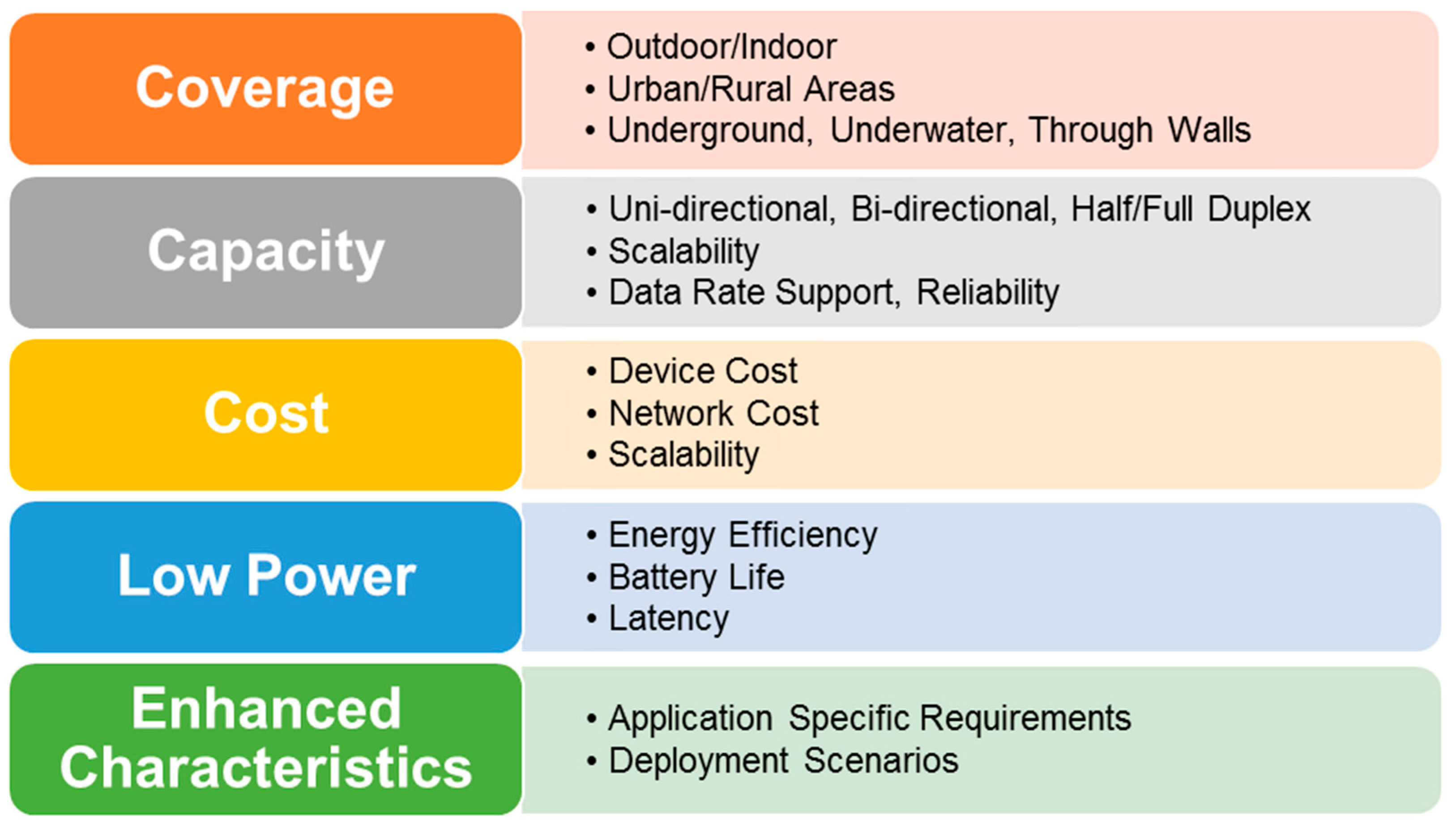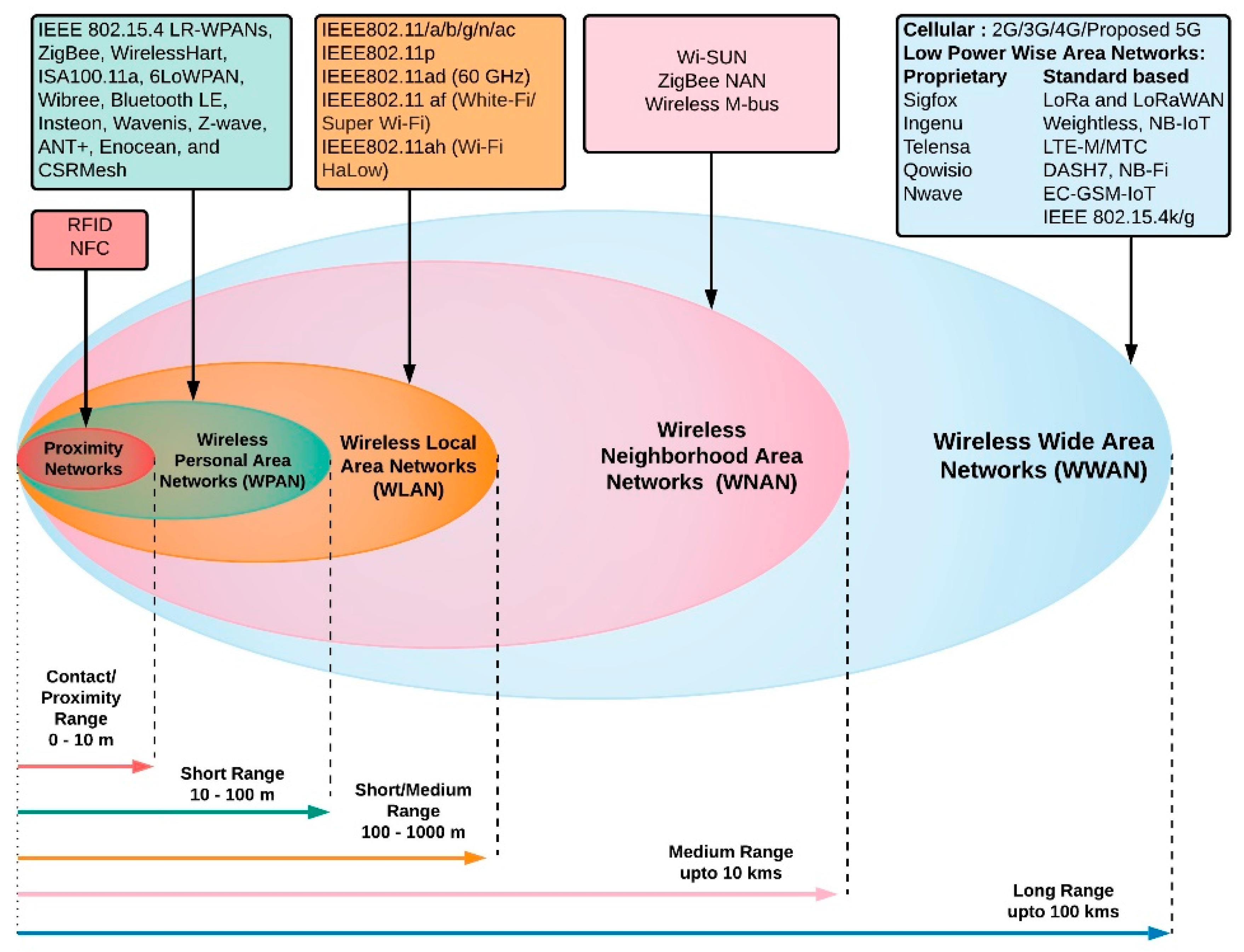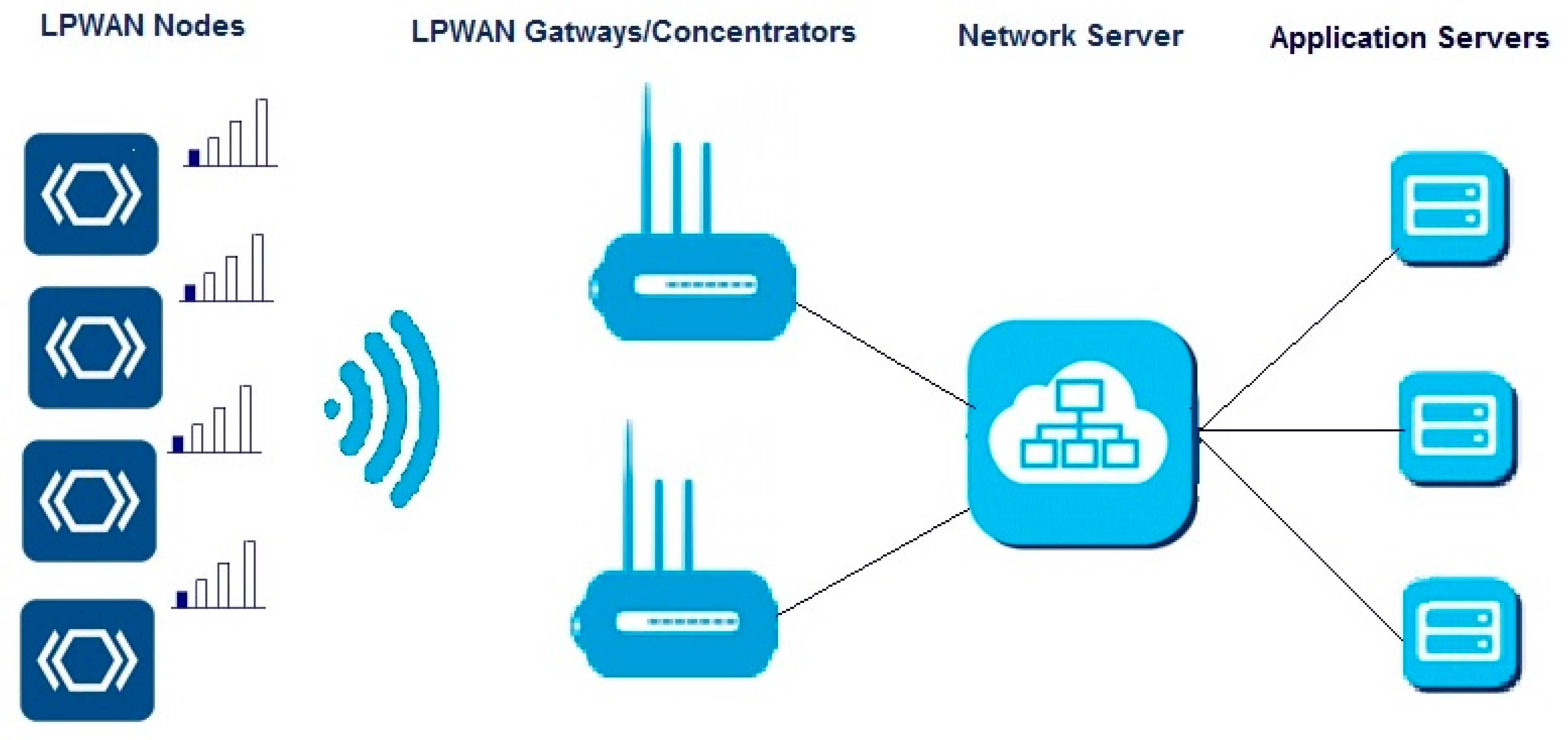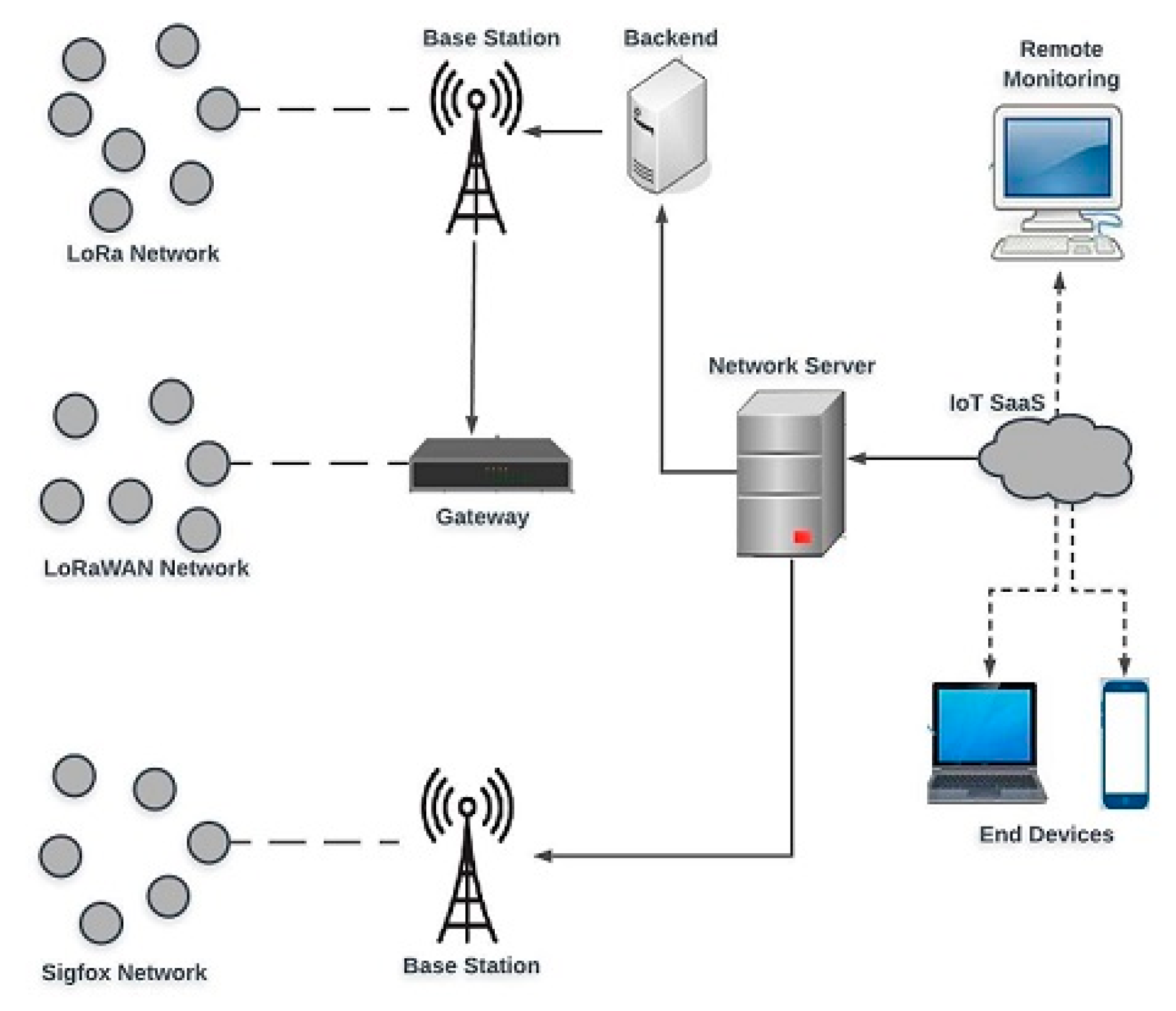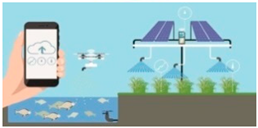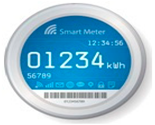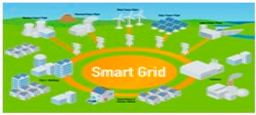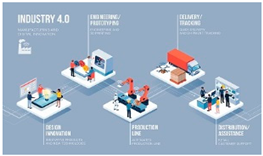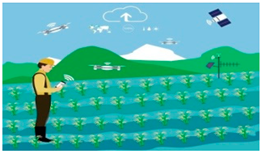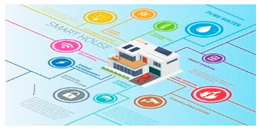1. Introduction
With the emergence of the Internet of Things (IoT) and machine to machine (M2M) communications, massive growth in the sensor node deployment is expected soon. The IoT survey reported on the Forbes website [
1] forecasts more than 75 billion IoT device connections by 2025. These connected IoT devices include connected cars, machines, meters, sensors, point-of-sale terminals, consumer electronics products, wearables, and others. The exponential growth in IoT is impacting virtually all stages of industry and nearly all market areas. It is redefining the ways of designing, managing, and maintaining networks, data, clouds, and connections. With highly anticipated developments in the fields of artificial intelligence, machine learning, data analytics, and Blockchain technologies, there is immense potential to exponentially grow LPWAN deployments and applications in almost all the sectors of society, profession, and the industry. Such progression allows devices such as sensors, vehicles, robots, machines, or other such objects to connect to the Internet. The network enables them to send the sensed data and parameters to the remote centralized device or server, for example, the cloud. The cloud provides intelligence for making an appropriate decision or actuating action.
In general, IoT applications require energy-efficient and low complexity nodes for a variety of uses that are to be deployed on scalable networks. Currently, wireless technologies such as IEEE 802.11 wireless local area networks (WLANs), IEEE 802.15.1 Bluetooth, and IEEE 802.15.3 ZigBee low rate wireless personal area networks (LR-WPANs) are being used for sensor applications in short-range environments. WLAN and Bluetooth were designed primarily for high speed data communication, whereas ZigBee and LR-WPAN are used for low data rate application in local environments. In contrast, wireless cellular networks such as 2G, 3G, and 4G are designed primarily for voice, data, and video communication, not for wireless sensor applications. These are used primarily for large coverage applications. Such cellular networks generally do not meet the performance metrics required for sensor applications.
Hence, to support such requirements, a new paradigm of IoT, called a low power wide area network (LPWAN), has evolved. LPWAN is a class of wireless IoT communication standards and solutions with characteristics such as large coverage areas, low transmission data rates with small packet data sizes, and long battery life operation [
2]. The LPWAN technologies are being deployed and have shown enormous potential for the vast range of applications in IoT and M2M, especially in constrained environments. The key expectations are device costs in the
$3–
$7 range, packet sizes from 10 to 1000 Bytes at uplink speeds of up to 200 kbps, battery life of 10+ years, support for 100K+ devices, and coverage from 2 km to 1000 km [
3]. These characteristics are expanded in many cases to address new applications. Hence, in addition to these core LPWAN characteristics, there are applications that may require larger data sizes and varying bandwidth, may tolerate somewhat reduced coverage, and may allow some compromise on cost. A typical LPWAN technology is designed using a set of design considerations and architectural constructs derived from these core and additional characteristics. The design constructs result in various tradeoffs, especially cost, performance, and hardware and software complexity.
This paper is primarily focused on defining a systematic and powerful approach of identifying the key characteristics of LPWAN applications, translating them into explicit requirements, and then deriving the associated design considerations [
4] for present and future technological candidates. The remaining paper is organized as follows.
Section 2 discusses the emerging and intelligent applications of LPWANs and their characteristics.
Section 3 briefly describes and categorizes various wireless access technologies.
Section 4 translates LPWAN application characteristics from
Section 2 to corresponding requirements to provide specificity to the generic characteristics.
Section 5 develops the associated design considerations for the requirements developed. LPWAN topologies and architectures are presented in
Section 6. Proprietary and standards-based LPWAN candidate technologies are introduced in
Section 7.
Section 8 summarizes the interrelationship between LPWAN and cellular 5G technology. Concluding remarks are provided in
Section 9.
2. Intelligent Applications and Their Characteristics
The growing popularity of IoT use cases in domains that rely on connectivity spanning large areas and the ability to handle a massive number of connections is driving the demand for LPWAN access technologies. With the advancement in the fields of miniaturized electronics, communication, computing, sensing, actuating, and battery technologies, it is possible to design low power, long range networking technologies with many years of battery life and tens of kilometers of coverage. These technologies have to be Internet-compatible so that data, device, and network management can be undertaken through cloud-based platforms. LPWAN technologies can be deployed for a broad range of smart and intelligent applications, including environment monitoring, smart cities, smart utilities, agriculture, healthcare, industrial automation, asset tracking, logistics and transportation, and many more, as given in
Table 1 [
4].
3. Application Characteristics
Various applications have varying characteristics. Coverage, capacity, cost, and low power operation are of course the primary drivers for all LPWAN applications. However, some LPWAN solution may entail significant tradeoffs between different characteristics, for example, coverage versus cost. In addition, some applications are comparatively homogeneous, for example, meters, whereas others have a plethora of heterogeneous devices with varying expectations. In addition, selected applications require other capabilities, for example, interworking with other technologies and voice support. Hence, a specific LPWAN solution may be customized to a narrow set of applications, whereas another solution may be designed to cover a wide range of applications and attributes. For example, smart city applications require wide radio coverage to encompass all the parts of a city. Such application may include the measurement of many parameters such as environmental: humidity, temperature, pollution level, noise level; advanced metering infrastructure: electricity, gas, water meters; intelligent roads and transport parameters: traffic density in spacio-temporal pattern, smart parking, best route selection, manhole cover monitoring; road condition and bridges monitoring; intelligent street lights; intelligent homes: automated light control, temperature control, fire and smoke monitoring, security and alarm systems; and smart buildings: structural health monitoring, water tank monitoring, elevator monitoring, trash collection and waste management, security and safety, and many more.
Clearly, large numbers of LPWAN nodes are required for smart city applications, and hence the network should have large capacity and scalability. Applications like smart city may not be too concerned about monetary implications in an urban environment. Many of these nodes can be powered through a power line and, even if they are battery operated, in most of the cases, replacement of batteries is possible, and hence low power consumption requirement is at a moderate level. Enhanced characteristics required for smart city applications could be important in several ways such as heterogeneity of devices and software platforms, varied radio coverage requirement, co-existence and interference mitigation.
Table 2 provides the relevance of the major characteristics to the selected applications mentioned above [
4,
5]. In addition to the primary categories of coverage, capacity, cost, and low power operation, another characteristics area titled ‘enhanced characteristics’ is added. This covers the additional features that may be needed for a specific application. The relative scales for applicability of the characteristics to the application are high (H), medium (M), and low (L). For an LPWAN solution targeted towards a given application, the table provides the tradeoffs for architectural and design decisions.
Coverage is of fundamental value to almost all LPWAN applications, and hence it is identified to be of high relevance for most of them. However, a typical manufacturing environment may entail localized operations. In such a case, tradeoffs may be carried out to focus on the types and number of devices to be supported, and coverage requirement may be compromised. Low power operation is driven primarily by the non-availability of electric power supply, for example, agricultural applications. In such situations, various sensors are far out and sometimes in difficult to reach locations, and hence batteries lasting 10+ years without recharging are needed. Low power operation is considered to be of high significance in such applications. In others, for example, retail, electric power may be readily available, and low power operation may be considered of low priority. In many instances, an application with the massive number of devices requires very low cost devices, for example, smart metering, whereas others like smart homes may be able to absorb reasonable cost. This is hence captured as of low relevance for such applications. The major attributes for these characteristics [
4] are summarized in
Figure 1.
4. Wireless Access for IoT Applications
Wireless access networks for IoT applications span different geographic ranges, as shown in
Figure 2 [
4]. Wireless personal area networks (WPANs) based on radio frequency identification (RFID) and near field communication (NFC) are the near-me area network type communication networks for devices in close proximity.
WPANs are used to convey information over short distances among the group of participating devices with little or no infrastructure. These networks can be connected to cloud platforms through a centralized device or server. Most of the WPANs are designed for low data rate, power efficiency, and short distance, and are meant to be inexpensive solutions. Prominent WPAN technologies include IEEE 80.15.4 low rate WPANs, ZigBee, WirelessHart, ISA100.11a, 6LoWPAN, Wibree, Bluetooth low energy (BLE), Insteon, Wavenis, Z-wave, ANT+, Enocean, and CSRMesh.
Wireless local area networks (WLANs) are primarily designed for high speed data exchange between the devices with campus-wide coverage limited to a few hundred meters. WLAN technologies include the different flavors of the IEEE 802.11 standard. In addition, wireless neighborhood area network (WNAN) has evolved as a new architectural system for broadband wireless local distribution applications, which comprise of a service area smaller than metropolitan, but larger than local area networks. It can be used for residential, campus, and street-level environments for utility and smart grid applications. The technologies for WNAN are Wi-SUN, ZigBee NAN, and Wireless M-bus.
Wireless wide area networks (WWANs) are designed to cater to larger areas compared with WLANs and WNANs. They have different requirements for different applications in terms of coverage, power efficiency, data rates, scalabilities, resource reuse, and others. WWANs can be broadly classified into cellular and LPWANs. Cellular networks such as 3G and 4G are primarily designed to transfer data at a high rate for a few to tens of kilometers. These networks support mobility, and hence provide extended coverage beyond the range of a single cell via handover mechanisms. LPWANs are the wireless communication technologies designed to allow long range communications with low power consumption, low cost interface, and a relatively low bit rate for IoT and M2M applications. LPWAN is a major segment of IoT-based applications that span a long distance and are sensitive to both cost and power consumption. It is estimated that one-quarter of overall IoT/M2M devices will be connected to the Internet using either proprietary or standard LPWAN technologies. LPWAN solutions typically involve a massive number of end devices, send small-sized infrequent messages, and are tolerant of reasonably long end-to-end delays. Reliability requirements vary depending upon the application. LPWAN technologies complement and sometimes supersede the conventional cellular and short-range wireless technologies in performance for various emerging applications [
6].
Most of the intelligent applications will require some combinations of the above wireless access solutions.
5. LPWAN Application Requirements
The extensive range of LPWAN applications correspondingly results in a wide variation in the characteristics mentioned in
Section 2. Devices may span coverage ranging from very short to remote distances, from stationary to moving positions, from battery-based low power to commercial power-based connections, and a range of friendly to hostile environments. The coverage span for some applications is highly localized, for example, indoor stationary deployments. Applications involving device mobility, such as asset tracking, require global service coverage [
7]. The massive IoT application segment requires connectivity for a large number of devices in contrast to critical IoT applications that require ultra-low latency and ultra-high reliability. A significant segment of low power wide area solutions typically sends small-sized messages infrequently, are delay-tolerant, do not need high data rates, and require low power consumption and low cost.
The characteristics from
Section 2 can be mapped into a set of requirements [
4]. The key requirements relate to handling of M2M traffic, massive capacity, energy-efficiency, low power operations, extended coverage, security, and interworking.
5.1. Traffic Requirements
The inherent communication mechanism of LPWAN networks entails traffic generated by distributed sensors. In addition to the possible presence of traffic created by smartphones or other devices, the LPWAN traffic itself can vary in a wide range of attributes like the number of messages, message size, and reliability requirements. LPWAN technologies have diverse categories of applications with varying requirements. Some of the applications are delay-tolerant (e.g., smart metering), while applications like fire detection, nuclear radiation detection, and home security require prioritized and immediate transmission. In some applications, a priority message scheduling may be required for event-triggered transmissions. With the massive number of active devices, there is a possibility of a service level agreement (SLA) requirement of each application that might not be satisfied. Mechanisms need to be supported for the co-existence of different traffic types, the required quality of service (QoS), and SLA. In LPWAN applications, provision may need to be made for handling multiple classes of end devices based on their communication needs in uplink or downlink. In some applications, device mobility support is needed and is required to be able to be connected anywhere and ensure seamless service on the move.
5.2. Capacity and Densification
One of the essential requirements for LPWAN is to support a massive number of simultaneously connected devices with low data rates. Many applications require support for 100,000+ devices in a scalable manner. Scalability refers to the ability to seamlessly grow from a network of a small number of heterogeneous devices to massive numbers of devices, new devices, applications, and functions without compromising the quality and provisioning of existing services [
8]. As LPWAN end devices have low computational and power capabilities, network devices such as gateways and access stations can also play a vital role in enhancing scalability. Employing multi-channel and multi-antenna based on different diversity techniques can also significantly improve the scalability of LPWAN networks. However, it is to be ensured that such features do not compromise other performance metrics. A large number of devices also results in high densification [
6]. The network needs to mitigate the issues of bottlenecks in media access and interference, and avoid degradation of performance of the network
5.3. Energy Efficient Operations and Low Power Sources
In several applications of LPWANs, the environment and the constraints do not allow the recharging of batteries. The battery is expected to last over ten years without charging. Typically, AA or coin cell batteries are used. If the battery loses power, replacement of the battery may not be possible within short periods. The cost of battery needs to be low. The LPWAN should be operated with a strict and very low duty cycle limit so that node lifetime can be enhanced. Hence, ultra-low power operation is a crucial requirement for battery-powered IoT/M2M devices.
5.4. Coverage
The range of operations requires both long range as well as short range communications. Typically, LPWAN needs to provide long range communication up to 10–40 km in rural/desert zones and 1–5 km in urban zones with +20 dB gain over the legacy cellular networks [
6,
9]. For applications involved in monitoring and collecting data, coverage may need to be provided for indoor, hard to reach locations like underground locations and basements. Coverage needs to be consistent with expectations on adaptable data rates and managed data error rates. Use of the sub-GHz band helps most of the LPWANs to achieve robust and reliable communication with a lower power budget because the lower frequencies of the sub-GHz band have better propagation characteristics as compared with the 2.4 GHz band and higher bands. Additionally, the low modulation rates used for LPWAN put more energy for each bit, and hence increase the coverage. A lower modulation rate also helps the receivers in demodulating the signal correctly.
5.5. Location Identification
Location identification for devices is a crucial requirement. Location accuracy plays a key role in applications such as logistics and livestock monitoring. The resolution range may vary from a few centimeters to meters. Monitoring and security for sensing unusual events such as changed device location and facilitating the proper level of authentication need to be supported. Location identifications can be achieved by global positioning system (GPS), GPS-like systems, or running smart algorithms with the help of network infrastructure.
5.6. Security and Privacy
The security requirements for LPWAN devices are particularly stringent because of the massive number, vulnerabilities, and simplicity of the devices. The essential attributes of authorization, authentication, trust, confidentiality, data security, and non-repudiation need to be supported. The security support should be able to handle malicious code attacks (such as worms); handle hacking into LPWAN devices and system; and manage eavesdropping, sniffing attacks, and denial of service (DoS) attacks [
8]. It is also important to protect the device identity and its location privacy from the public. Additionally, it should also support security for the forward and backward transmission as required in various applications.
5.7. Cost Effectiveness
LPWAN applications are particularly sensitive to device and operational cost. In addition to the standard requirements of low deployment and operating costs for the network, the large number of devices involved puts major constraints on cost, operational expenses, and an imperative of low power consumption. Software upgradability without changing hardware is a key attribute that needs to be supported. Besides, it becomes imperative to support scalability, easy installation, and low cost maintenance.
5.8. Reduced Device Hardware Complexity
In order to handle the large number of devices, low cost operation, and long range coverage, the design of small-sized low complexity devices becomes an essential requirement. The reduced hardware complexity structure enables the reduction of the power consumption in battery-powered devices, without sacrificing too much performance. The devices generally are expected to possess low processing capabilities. Simple network architecture and protocols need to be supported by the hardware. From a technology point of view, in order to achieve the required adaptability of the LPWAN devices, radio transceivers need to be flexible and software-reconfigurable.
5.9. Range of Solution Options
To allow flexibility and choices for the customer, operation support in both licensed and unlicensed bands is desired. The unlicensed spectrum may be derived from the industrial, scientific, and medical (ISM) band. In many instances, customers prefer solutions that are upgradable from existing wireless access systems. There are demands for custom, proprietary, and standards-based solutions. Applications require configurability between different topologies, including star, mesh, and tree.
5.10. Operations, Interrelationships, and Interworkings
The network should be able to handle heterogeneous devices. These large numbers of devices may share the same radio resources causing intra- and internetwork and technology interference, resulting in a degradation of network performance. Hence, LPWAN devices should possess the ability to connect and operate in varied LPWAN technology environments with interference tolerance, handling, and mitigation capabilities. The network should be able to enable connectivity of devices irrespective of hardware infrastructure and application programming interface (API). Seamless end-to-end interoperability needs to be supported between different network technologies. This may require standardization and gateways with adaptability protocols between various communications technologies. Full end-to-end application integration is expected.
In summary, the LPWANs are resource-constrained networks and have the critical requirements for long battery life, extended coverage, high scalability capabilities, low device cost, and low deployment cost.
6. Design Considerations for LPWAN Networks
Table 3 summarizes the key design considerations needed to meet the requirements [
4] stated in
Section 5. Such a traceability approach of associating requirements with their corresponding design considerations is a powerful and effective tool to ensure that each requirement can be mapped to its corresponding design entities for ensuring the coverage of the requirement. It may be noted that a design construct may be addressing multiple requirements as well. The design considerations are grouped into two categories—desirable and enhancement. Desirable or expected design constructs are the typical basic capabilities for LPWAN networks. They are generally applicable for homogeneous-type lower-end IoT applications. Design constructs identified as enhancements are applicable for selective applications, and may be needed to enhance specific characteristics, handle heterogeneous traffic environments, or manage varying types of devices in the same LPWAN network. Many of these enhancements primarily impact the access platform and not necessarily the device.
6.1. Traffic Requirements
Support for the varying nature of devices and traffic with differing attributes of bandwidth, latency, size of packets, and so on drive a range of design considerations. Minimally, LPWAN technology needs to provide basic admission and user traffic management depending upon its network access architecture. Some LPWAN technologies may send data without having to undertake any elaborate admission activity and data bearer setup. On the other hand, another technology may decide to go through protocol-based admission control and data bearer setup. Basic admission and user data transmission is particularly relevant to applications where the traffic is homogeneous and limited, and all devices are of the same type, for example, meters only. However, for heterogeneous devices and co-existence of varying types of devices in the same LPWAN network, these capabilities need to be enhanced. Admission control mechanisms may need to have the capabilities of handling congestion, selectively blocking off admission for new traffic requests, and being able to handle admission on a priority basis. In some applications, multiple levels of device traffic priority management may be needed with different attributes of guaranteed and nonguaranteed bit rates for device data bearers.
For applications requiring mobility, the use of a control plane to carry selected data traffic may be invoked in order to handle overload traffic conditions. For minimizing the processing load on the devices, several capabilities, for example, support for handovers, need to be implemented primarily in the access station instead of in the device.
6.2. Capacity and Densification
From a capacity viewpoint, the LPWAN technology needs to support and provision a large number of devices in a scalable manner. Globally unique identifiers and software upgrade capabilities are needed so that each device is uniquely addressable. Scalability needs to be supported without requiring physical access to or hardware changes in the device. To maximize scalability and network capacity, individual links need to be optimized for high link quality and reliable and energy-efficient communication needs to be supported. For applications with device heterogeneity, standardized protocols are required. A large number of devices and dense deployments of base stations also cause high levels of interference between signals from different devices. The basic approach to reduce interference is to use frequency reuse as part of network planning. In some instances, communication may need to be made resilient to interference by using adaptive modulation schemes, multiple channels, and doing redundant transmissions [
6].
Efficient exploitation of diversity in channel, time, space, and hardware may be used. In some specialized applications, parallelization in transmission may need to be implemented by taking advantage of techniques like multi-channels and multiple input multiple output (MIMO) configurations. As technology is advancing, the software defined radio (SDR) can be a good option for optimizing access and performance in an efficient manner. For selected applications where cost considerations and energy efficiency are important, such robust techniques are optional.
In situations with a large number of devices and densification, as well as strong and efficient multi access techniques, are needed owing to limited air resource issues and the potential for cross-technology interference. A possible multi-access approach can be non-orthogonal multiple access (NOMA) [
10]. It may be noted that NOMA is also being considered for 5G access networks. NOMA can be applied to support diverse quality of service (QoS) requirements for differing types of end devices. Using NOMA, devices can achieve multiple access by exploiting power and code domains techniques. All the devices can utilize resources simultaneously. However, this can create inter-device interference. To mitigate this, multi-device detection techniques, for example, joint decoding or successive interference cancellation, can be used to retrieve the device’s signals at the receiver.
Multiple and adaptable link level configurations may need to be supported with tradeoffs between different performance metrics such as bandwidth, latency, error rate, and so on. This implies a need for adaptive techniques that can readjust their parameters for better performance based on monitoring of link quality. Adaptive modulation schemes, selection of better channels to reach distances reliably, or adaptive transmission power control are some of the techniques that can be utilized. There is a significant need to develop novel densification approaches, especially in many proprietary solutions. Such technologies may not be able to utilize the synchronization technique and well-coordinated radio resource management. The dynamic state and context information need to be stored for the devices in the access station and the core entities. Managing the state information of the massive number of connected devices is also an issue that needs to be addressed.
6.3. Energy-Efficient Operations and Low Power Sources
Energy-efficient operations involve decreasing complexity and enabling efficient utilization of resources. The following are some key design considerations for extending the lifetime of devices to 10+ years of operation.
For energy-efficient designs, the use of multiple energy-saving low power modes, for example, sleep mode, is a desirable approach. A significant number of LPWAN applications involve sending of frame sizes of the order of tens of Bytes transmitted a few times per day at ultra-low speeds [
11]. For such applications, the intent is to operate the nodes with an extremely low duty cycle so that the nodes will be in sleep mode most of the time. Selected high power consuming elements like data transceivers may be turned off when not required. This reduces the amount of consumed energy. Only when data are to be transmitted or received, the transceiver is to be turned on. In the case where data are to be transmitted by the access station, the access station may wait until the time of sleep has expired, or it may send explicit wake-up signals.
Media access control (MAC) is particularly influential in improving resource utilization efficiency and extending battery life. Efficient resource utilization can be done via scheduling optimization. Efficient scheduling involves the assignment of transmission resources to selected devices with higher levels of channel quality. Another approach for extending battery life is by harvesting energy from other sources. Natural sources, for example, wind or solar power, can be used. However, these sources may be unpredictable and unreliable. Capacitors may be utilized to store energy from these types of alternate sources. For consistent availability of energy, power may be derived from radio frequency signals that transfer control and data information. There is a tradeoff between the lifecycle of a battery without these enhancements versus the resulting availability of additional power from the alternate sources after you take into account the overhead of these enhancements.
Lightweight MAC protocols and techniques to offload complexity from end devices are some typical techniques that may be considered for energy efficiency. Use of simple media access techniques is an example of such an approach. In order to match the range and data rate requirements, flexible and inexpensive hardware designs are needed for implementing multiple physical layers [
11]. Each of these layers can offer complementary solutions to corresponding applications.
Generally, from an energy consumption perspective, communication operations consume more energy than processing operations in end devices. Power utilization in the devices can be reduced by using less complex or less frequent communication mechanisms as long as the corresponding additional processing power is still manageable. As an example, to reduce communication overhead, sending a large number of unformatted data can be replaced by consolidating them into one formatted package prior to their transmission.
With the increasing number of connected LPWAN devices, additional design considerations that can be explored include the use of channel diversity, opportunistic efficient spectrum utilization, and adaptive transmission. The use of MIMO at the LPWANs access stations can also significantly increase the diversity gain or the data rates. Using space division multiplexing, the access station can boost the number of LPWAN devices that it can support.
Efficient spectrum utilization pertains to optimized usage of the overall spectrum resources in time, frequency, bandwidth, and spatial dimensions. In many instances, the spectrum is not fully utilized. The access station or the device can sense and identify the gaps in spectrum usage and improve the efficiency of spectrum utilization [
12]. Such an approach can also reduce cross-interference.
6.4. Coverage
Coverage is a critical attribute for LPWAN-based applications. There are several aspects of coverage—reaching a larger geographical area, areas around obstructions, and areas inside buildings. Techniques to overcome issues associated with degradation of signal include repeated transmission, boosting of transmitter power, improving sensitivity of antennas and transceivers, and decreasing the modulation rate. The last item increases the probability of successful detection. It may be noted that, similar to the scenarios for capacity, weak signals in enhanced coverage also result in additional interference. The techniques for interference management mentioned in handling capacity are also applicable to such situations.
Repeated transmissions entail sending the same data a defined number of times with the same or different error detecting codes. The receiver processes multiple copies of the packets received and extracts the data information. Power boosting implies increasing the transmission power to provide higher coverage. To handle low levels of signals and increase coverage, antenna configuration may be enhanced, and receiver sensitivity can be increased. It may be noted that, the lower the modulation rate, the higher the probability of detecting bits correctly. However, a lower modulation rate also decreases the spectrum efficiency (bps/Hz.), thus reducing the data bandwidth. This may be acceptable for many applications.
6.5. Location Identification
Determining the location of the devices is an important requirement for typical IoT applications. Devices in cellular network-based infrastructure have a built-in location method based on a cell ID. This capability is cost- and battery-effective, but is usually only as accurate as the cell site’s footprint. Time differences of arrival (TDoA) designs locate devices using the available infrastructure, including gateways. Because gateways and cells are able to collect and transmit timing information, devices can be located by comparing the time associated with the arrival of signals at multiple gateways or cells, sometimes called the triangulation scheme. It is one of the lowest cost solutions. Satellite-based location methods also work nicely for use cases that are not particularly battery sensitive.
6.6. Security and Privacy
Security threats arise, especially owing to the heterogeneity of and physical accessibility to devices and the openness of the systems connected to the Internet through the LPWAN wireless air interface [
12]. The risk of vulnerability to cyber-attacks is particularly relevant to IoT LPWAN machine to machine (M2M) environments owing to the massive number of devices involved. To avoid intrusion and hacking, encryption of both the application payload and the network admission request needs to be considered.
Owing to cost and energy considerations, it becomes necessary for LPWAN networks to settle for simpler communication protocols for authentication, security, and privacy. Over-the-air (OTA), as an alternative to authentication by personalization (ABP), is a key facility to assure that end devices are not exposed to security risks over a prolonged duration [
13]. This may be comparatively expensive in proprietary LPWAN networks operating in unlicensed bands. In many networks, strong encryption and authentication schemes such as advanced encryption suite (AES) are used for confidential data transport, Diffie–Hellman (DH) is utilized for key exchange and management, and Rivest–Shamir–Adleman (RSA) is applied to authenticate digital signatures and key transport. These are based on cryptographic suites with robust protocols. Similarly, for 3GPP cellular-based systems, the subscription identity module (SIM)-based authentication technique provides comparatively robust protection.
Automating posture management and the use of software updates to patch vulnerabilities may be needed to isolate devices from potential attackers [
11]. In order to provide protection and to isolate the device and its application, an overlay network may need to be explored. This provides security as the unique local addresses used in the overlay network do not allow access from outside the overlay.
6.7. Cost Effectiveness
The cost effectiveness requirement fundamentally implies addressing several areas, especially reducing hardware, deployment, and operational costs. A key area is reduction in the complexity of the hardware. A software re-configurability facility needs to be provided so that the need for hardware upgrades is minimized. Processing and communications tasks need to be simplified. MAC and other protocol-related entities are to be architected and designed, resulting in minimal overhead. A skinny protocol structure instead of the robust seven-layer structure may be acceptable in some applications. A flat hardware architecture to minimize internal communications and interface complexity is another area for consideration. Generally, these may entail trade-offs, especially in the areas of modularity, reliability, and robustness.
6.8. Reduced Device Hardware Complexity
Reduction in hardware complexity has multiple advantages, including reduction of cost, device size reduction, and reduced power consumption. One key area of effecting hardware simplicity is the application of software reconfigurability to radio transceivers [
6]. Radios need to be able to operate over multiple-frequency bands and support varying types of waveforms, as well as various air interface technologies depending upon LPWAN-related and other interfaces. They need to be reconfigured based on software updates without hardware changes. Moreover, SDR is considered one of the key technologies that enable the use of optimized spectrum access. The adoption of integrated circuit (IC) technologies and low-complexity transceiver structures, such as the direct-conversion radio (DCR) architecture [
10], result in manufacturing efficiency. DCR requires neither external intermediate frequency filters nor the image rejection filter. Use of such simplification runs the risks of radio frequency imperfections, for example, in-phase and quadrature imbalance, phase noise, and amplifier nonlinearities. Several digital processing techniques that may cause energy consumption need to be applied to minimize the negative effects. These approaches usually require high complexity processing, and hence demand more energy. Therefore, there are tradeoffs in implementing the simplification techniques.
6.9. Range of Solutions Options
Options and flexibility of using different LPWAN technologies create competition, reduce cost, and provide meaningful LPWAN network options to the user. For this, the hardware, software, and protocols supported in the device need to be able to interface with multiple technologies. The device needs to support multiple physical layers and align with the corresponding protocols associated with selected LPWAN technologies. Such adaptability also extends to the availability of multiple options in terms of bandwidth and latency, consistent with the application attributes. Multi-mode and multi-frequency operations need to be supported on the devices. Multi-mode operations can interface with multiple technologies, whereas multi-frequency operation refers to the capability of operations on multiple frequencies on the same technology.
6.10. Operations, Interrelationships, and Interworking
Proprietary and standards-based LPWAN technologies have different strengths and weaknesses in terms of operations, co-existence, and interworking with each other. There are different challenges for the technologies operating in unlicensed and licensed bands [
10]. For unlicensed bands, flexibility and faster time to market are major advantages. However, the transceivers become more complex, and interference needs to be managed. Proprietary technologies also need to adhere to regional regulations on the use of a shared spectrum. These may put limits on their operations, for example, transmitted radio frequency (RF) power. For technologies operating in licensed bands, standardized solutions, QoS management facilities, and more robust control of the network and devices are major advantages. However, the cost, complexities associated with acquiring and managing the allocated spectrum, and delays in time-to-market are the issues to be handled. In either case, the use of sub-GHz frequencies achieves wider coverage and better penetration into buildings and underground installations. The use of sub-GHz frequencies also leads to lower interference and increased sensitivity, making these technologies more energy-efficient.
Traditionally, proprietary technologies optimize their costs by using customized implementations and lean and thin proprietary protocols. As competitiveness, portable services, availability of options to the users of multiple technologies, and utilization of common interfaces become more important, customized and simple protocols need to be replaced by standardized ones. Typically, communication based on Internet protocol (IP) between network server applications and the end devices becomes the interface of choice. This allows portable and more generic implementations based on IPv6 and constrained application protocol (CoAP) [
14]. To incorporate simplicity, diverse radio technologies may need to exploit the compressed form of IPv6 and CoAP. LPWAN device implementation requires a small frame size owing to its very low data rates. Hence, traditional compression techniques that rely on octet or two available to signal both IP and CoAP may not be appropriate. The higher level IETF stack structure can also be used. This involves tradeoffs with cost and simplicity, as well.
Cross-technology interference also influences the performance of LPWAN technologies. Therefore, service level agreements (SLAs) need to be put in place, especially for unlicensed band operations. Interoperability between heterogeneous technologies is crucial to the long term viability of LPWAN technologies. The issues mentioned in the previous paragraph also need to be addressed when it comes to interoperability. Again, standardized design structures and protocols become imperative. In addition, the emergence of new communication technologies introduces many integration challenges, including alignment of common practices, service descriptions, standards, and discovery mechanisms. This creates incompatibilities and does not allow interworking. Common application, identity, security, and service management models need to be utilized by any LPWAN technology desiring to work with others. For the technologies, this has an impact primarily on the physical and MAC layers in addition to work related to adherence to IP and IETF standards for higher layers.
7. LPWAN Topologies and Architecture
This section summarizes the connectivity topologies applicable to LPWAN networks and the architectural framework associated with them [
4]. Proprietary and standards-based LPWAN solutions use a set of topologies geared towards the applications they serve and the set of requirements on which they want to focus. From the topology viewpoint, LPWAN networks can be classified into two major groups—star and mesh. A selected technology can be configured into either of these groups if it is equipped with the designs needed for the topology and if deployment facilities exist to support it. Cellular technologies are generally versatile in this respect, and they also support mobility. There is a set of basic entities that form the architecture for LPWAN networks. Typical architectures are covered subsequently in this section.
7.1. LPWAN Topologies
Prominent topologies are star and mesh. Generally, star or star-on-star topology is preferred for LPWAN over mesh networks for preserving battery power and increasing the communication range. LPWAN’s long range connectivity allows such single-hop networks access to a large number of nodes, thus reducing the cost. From a coverage viewpoint, traditional wireless sensor technologies such as ZigBee, Bluetooth, and Wi-Fi are not designed for wide coverage, and hence are not directly applicable as LPWAN technologies.
The simplest form of wireless network topology is a point-to-point network in which nodes communicate directly with a central node. It is often used for remote monitoring applications and can be useful in hazardous environments where running wires is difficult or dangerous. Such LPWAN technologies support a star topology, as shown in
Figure 3a. A star network consists of one gateway node to which all other nodes connect. Nodes can only communicate with each other via the gateway. Node messages are relayed to a central server via gateways. Each end node transmits the messages to one or multiple gateways. The gateway forwards the messages to the network server, where redundancy, errors, and security checks are performed. Star networks are fast and reliable because of their single hop feature. Faulty nodes can also be easily identified and isolated. However, if the gateway fails, all the nodes connected to it become unreachable. As the end node sends messages to multiple gateways, there is no need for gateway-to-gateway communication. This simplifies the design as compared with networks where the end nodes are mobile. Mesh topology network consists of a gateway node, sensor nodes, and sensor-cum-routing nodes connected, as shown in
Figure 3b.
All the nodes can connect directly to each other in a full mesh topology. In a partial mesh topology, some nodes are connected to some of the others, but others are only connected to those with which they exchange the most messages.
Mesh networks have several advantages, such as availability of multiple routes for reachability, simultaneous up/downstream transmissions, easy scalability of the network, and capability of self-healing. These networks have some disadvantages, including complexity owing to redundant nodes, added latency because of multi-hop communication, and an increase in cost. The redundancy of nodes also compromises the energy efficiency of the network.
7.2. Major Architectures in LPWAN Technologies
The basic LPWAN architecture requires wireless access and connectivity to the Internet and the cloud. Typical LPWAN technology may require a selected set of architectural entities, as shown in
Figure 4 [
4].
The basic function of an LPWAN device is to collect data and respond to inputs from the LPWAN. Collected data are sent on a specific radio link to the wireless access station and on to the IoT network. The access station provides the radio link for device management and device traffic exchange. It maintains the integrity of the radio link by handling acceptable bit error rates, admissions, security, and so on. The access station interfaces with the gateway/concentrator, which, in some instances, is also called a core. There are different implementations depending upon the proprietary or standards-based LPWAN technology being considered. The core is responsible for handling control and user plane traffic. It provides a conduit for information exchange between the access station and the IoT network and supports translation between the protocols supported by the access station on one side and by the network on the other. Depending upon the technology, a concentrator may provide edge computing and storage facilities to offload the cloud. Because of its relative proximity to the end devices, this is particularly applicable to cases where the device requires real-time support with low latency. For selected LPWAN technologies, the core may provide robust admission, priority treatment, and mobility support if applicable. The LPWAN server is responsible for provisioning, registering, and operations for the LPWAN entities. It may also share or augment core functionalities like routing of traffic, security, and priority handling with the core. The application servers and the cloud support the LPWAN in carrying out the management of the database that contains the messages received from all the connected objects. It may use big data analytics to analyze and act upon the data.
7.3. Mixed Hybrid Architectures
The basic architecture provides direct device connectivity to the access station associated with the LPWAN technology. Other access configurations may also be considered. Two such prominent ones are discussed here.
Figure 5 shows the architecture wherein the primary connectivity to a device is provided by different access technologies like ZigBee, Wi-Fi, and so on. The corresponding gateway interfaces with the access point of an LPWAN. This is particularly relevant for cellular LPWANs.
Another architecture that uses multiple LPWAN networks for providing a range of interfaces to end devices [
15] is shown in
Figure 6. It shows an example where devices have access to both LoRa and Sigfox systems. Such multi-technology resident hybrid networks are particularly relevant for complex applications requiring different LPWAN technologies. Each LPWAN technology collects the data from the devices and nodes located in their coverage areas. The corresponding base or access stations are deployed consistent with their coverage area. The LPWAN gateway or nodes can communicate the user traffic data to the core network and the cloud. In such a mixed architecture, the associated network server or core network entities perform the functions of device management such as registration, authentication, resource allocation, and data traffic management to the devices connected to their network.
New approaches and architectures based on artificial intelligence (AI) to create cognitive-LPWAN solutions are also being studied [
16]. These approaches require powerful cognitive computing ability to support advanced communication, handle heterogeneous IoT applications, and enable software defined networking (SDN). Cognitive-LPWANs support co-existence and interworking of a mix of a variety of LPWAN technologies and provide users with more efficient and convenient intelligent services. It supports several applications, including smart cities, green IoT, and general heterogeneous networks, as well as AI applications such as smart home, health monitoring, automatic driving, and emotional interaction.
8. Introduction to Proprietary and Standards-based Solutions
The major LPWAN solutions can be classified into two categories—proprietary and standards-based. In the following, the major LPWAN technologies are introduced [
4].
8.1. Proprietary Technologies
8.1.1. Sigfox
Sigfox [
17] is a proprietary ultra-narrowband LPWAN technology that uses a slow modulation rate to achieve longer range. Initially, Sigfox supported only unidirectional uplink communication, that is, between the sensor devices to the aggregator with differential binary phase shift keying (DBPSK) modulation. The later releases support bi-directional communication, where Gaussian frequency shift keying (GFSK) modulation is used for downlink. This ultra-narrowband feature of Sigfox allows the receiver to only listen in a tiny slice of the spectrum so that the effect of noise can be mitigated [
18]. Like LoRa, Sigfox also uses unlicensed ISM bands. Sigfox has inexpensive sensor devices and cognitive SDR-based access stations to manage the network and for Internet connectivity. Sigfox supports very a low data rate compared with other LPWAN technologies. To provide reliability, Sigfox transmits the message multiple times, resulting in high energy consumption. One of the main differences between Sigfox and LoRa is business distinction. Sigfox is deployed by network operators, and the users need to pay the subscription charges, whereas LoRa can be deployed as an own independent network with no subscription charges. Sigfox gateway can handle up to a million connected objects, with a coverage area of 30–50 km in rural areas and 3–10 km in urban areas [
19].
8.1.2. Ingenu
Ingenu is based on the proprietary random phase multiple access (RPMA) technique with more flexible spectrum regulations, allowing higher throughput and capacity [
20]. The solution is proprietary in the sense that the company is the sole developer and manufacturer of the hardware. It uses a direct sequence spread spectrum technique with a peak data rate up to 80 kbps. Ingenu operates in the 2.4 GHz band, which gives it a shorter range than Sigfox and LoRa, and also encounters more propagation loss from obstructions, like water or packed earth. The 2.4 GHz band is widely used by many other personal and local area network technologies such as Wi-Fi, Bluetooth, and ZigBee, making it more congested, and hence resulting in an increase in the interference level. It offers low-power, low cost, robust, and bi-directional communication. To add reliability to the transmission, it provides acknowledged transmission. As it has higher data transmission rates, the power consumption is more than Sigfox and LoRa [
21]. Ingenu was originally designed and focused towards applications in utility, oil, and gas sectors. Nowadays, it is being proposed for a diverse range of applications such as smart city, agriculture, asset tracking, fleet management, and smart grids, among others.
8.1.3. Telensa
Telensa is an ultra-narrowband LPWAN technology. It works in 868 MHz and 915 MHz unlicensed ISM bands. It has bi-directional communication capabilities, and hence it can be used for monitoring as well as for control. It has a central management system (CMS) called Telensa PLANet, which is used for end-to-end operations. It has been adopted for intelligent street lighting application. It consists of wireless nodes connecting individual lights in a dedicated network [
22]. CMS reduces overall energy consumption and maintenance costs through its automatic fault detection system. These sensor nodes on the street light poles can be used for gathering the data of various parameters such as pollution, noise level, temperature, humidity, radiation level, and so on, as required in the smart city applications. One Telensa base station can control 5000 nodes with low power for around 2 km in urban and 4 km in rural areas. It supports integration with support services such as asset management, metering, and billing systems. Telensa is presently available in more than 30 countries worldwide.
8.1.4. Qowisio
Qowisio is an ultra-narrowband, dual-mode technology for LPWAN applications. It is compatible with LoRa and provides technological choices and flexibility to the end-users [
23,
24]. It offers connectivity as a service to the end-users by providing the end devices, deploying the network infrastructure, developing customized applications, and hosting them at a backend cloud. Qowisio has a full range of intelligent devices supporting different applications such as asset management, perimeter control, motion detection, lighting, environment parameter monitoring, energy and power monitoring, tracking, and several others.
8.1.5. Nwave
Nwave LPWAN is primarily a solution developed by Nwave [
25] for smart parking systems. This ultra-narrowband technology is also based on sub-1 GHz unlicensed ISM band operation. It claims long range and high node density as compared with Sigfox and LoRa at the cost of higher power consumption [
26]. It works in a star topology and supports mobility of the nodes. Nwave end node transmits power from 25 mW to 100 mW, thus covering a longer distance for the data rate up to 100 bps. It also claims coverage of up to 7 km and 8 years for the in-built node battery. It has its own real-time data collection and management software system for monitoring and control.
8.2. Standards-Based Technologies
8.2.1. LoRa and LoRaWAN
LoRa is a physical layer technology that works in unlicensed sub-GHz industrial, scientific, and medical (ISM) band and is based on the chirped spread spectrum (CSS) technique [
27]. CSS is a wideband linear frequency modulation in which carrier frequency varies for the defined extent of time. LoRa works on pure ALOHA principles and supports different ISM frequencies viz. 868 MHz (Europe), 915 MHz (North America), and 433 MHz (Asia). It is basically single-hop technology, which relays the messages received from LoRa sensor nodes to the central server via gateways. The data transmission rate supported by LoRa varies from 300 bps to 50 kbps, depending on the spreading factor and channel bandwidth settings. LoRa transmissions with different spreading factors are quasi-orthogonal and allow multiple transmissions with different spreading factors (SFs) simultaneously [
28]. To support LoRa on the Internet, LoRa alliance has developed LoRaWAN [
29], which includes network and upper layer functionalities. LoRaWAN provides three classes of end devices to address the different requirements of a wide range of IoT applications, for example, latency requirements. LoRa is one of the best candidates for long distance and low power transmissions.
8.2.2. Weightless
Weightless Special Interest Group (Weightless-SIG) proposed Weightless, an open standard offering LPWAN connectivity. There are three versions of weightless: Weightless-W, Weightless-N, and Weightless-Weightless-P. W is designed to operate in the TV white space (TVWS) spectrum (470 MHz to 790 MHz band), and it has better signal propagation as compared with Weightless-N and It supports a wide range of spreading codes and modulation techniques like DBPSK and quadrature amplitude modulation (QAM). The data packet size can be up to 10 Bytes with throughput ranging from 1 kbps to 10 Mbps, subject to link budget, and other settings [
30]. To enhance energy efficiency, end nodes communicate with the gateway with a narrow spectrum and at low power [
31]. As the use of TVWS is not permitted in many countries, Weightless-SIG has introduced two other variations, viz. Weightless-N and Weightless-P. Weightless-N (nWave) is similar to Sigfox and uses slotted ALOHA in the unlicensed band, supporting only unidirectional communication for end-devices to the base station. It achieves a communication range of up to 3 km with a maximum data rate of 100 kbps. Weightless-P uses Gaussian minimum shift keying (GMSK) and quadrature phase shift keying (QPSK) in the unlicensed band and offers bi-directional communication with support for acknowledgments. It achieves a data rate around 100 kbps, has a comparatively shorter communication range (2 km), and has a shorter battery life.
8.2.3. Narrowband IoT
Narrowband IoT (NB-IoT) is a 3GPP Release 13 LPWAN technology offering the flexibility of deployment by allowing the use of a small portion of the available spectrum in the long term evolution (LTE) bands. As a 3GPP technology, NB-IoT can coexist with global system for mobile communications (GSM) and LTE in licensed frequency bands of 700 MHz, 800 MHz, and 900 MHz. It supports bi-directional communication where orthogonal frequency division multiple access (OFDMA) is used for downlink, and single carrier frequency division multiple access (SC-FDMA) is used for uplink [
32]. It connects up to 50K devices per cell and requires a minimum of 180 kHz of bandwidth to establish communication. NB-IoT can also be deployed as a standalone carrier with a spectrum of more than 180 kHz within the LTE physical resource block. NB-IoT is designed by optimizing and reducing the functionalities of LTE so that it can be used for infrequent data transmissions and with low power requirements [
9]. The data rate supported is 200 kbps for downlink and 20 kbps for uplink. The maximum payload size for each message is 1600 Bytes.
8.2.4. LTE-M
LTE-M is also a 3GPP standard-based technology and operates in the licensed LTE spectrum. It is compatible with LTE networks and provides the connection for machine to machine (M2M) traffic. Also, the migration path from legacy 2G and 3G networks is available. It provides extended coverage as compared with LTE networks, coverage for M2M applications similar to 5G networks, and offers a seamless path towards 5G M2M solution [
8]. LTE-M is focused on providing variable data rates and support for both real-time and non-real time applications. It supports low latency applications, as well as deferred traffic applications that can operate with latencies in the range of a few seconds. It has low power requirements and supports operations ranging from low bandwidth to bandwidth as high as 1 Mbps. It also supports devices with a very wide range of message sizes. As it is derived from LTE as a base, mobility is supported as part of standard LTE functionality, but not in extended coverage scenarios [
33]. It is software upgradable from LTE. It has capacity for up to 100,000+ devices per base station for applications where devices have very low data-throughput requirements.
8.2.5. DASH7
DASH7, also known as DASH 7 Alliance Protocol (D7AP), was developed for wireless sensor and actuator communications and has originated from ISO 18000-7 standard. An extension of active radio frequency identification (RFID) technology, DASH7 [
34] is a low power long range ISM band technology primarily operating at 433 MHz. However, it also supports communication with other bands at 868 MHz and 915 MHz [
22]. It uses two-level GFSK modulation with a channel bandwidth of 25 kHz or 200 kHz along with data whitening and forward error correction features. It has a tiny open-source protocol stack supporting multi-year battery life, low latency, and more flexibility. It is used for low rate bursty data traffic up to 167 kbps. DASH7 supports multi-hop communication and mobility of nodes up to a range of 2 km [
35]. The architecture comprises of endpoints, sub-controllers, and gateways. Endpoint nodes follow a strict duty cycle schedule, while sub-controllers collect the data packets from the endpoint nodes with some sleep cycles and low power restrictions. Gateways are continuously active to collect the packets from sub-controllers and endpoints and then send it to the server. DASH7 supports tree topology in the presence of sub-controllers or star in the presence of the endpoints.
8.2.6. NB-Fi
NB-Fi (narrowband fidelity) LPWAN technology is designed for narrowband, low power, and long range bidirectional M2M communication applications [
22,
36]. This solution is designed by WavIoT—an Infrastructure as a Solution (IaaS) LPWAN provider. It works in 868 MHz and 915 MHz unlicensed ISM bands as well as other sub-GHz unlicensed spectrum. NB-Fi is an open, full-stack protocol with all seven layers of the OSI reference model for robust, reliable, and energy-efficient sensor communication. To achieve improved spectral efficiency and performance in the narrow bands, it employs smart and optimized spectrum utilization algorithms based on SDR technology, neural networks, and artificial intelligence techniques. NB-Fi has a decentralized architecture, allowing base stations to perform significant operations, making it more robust and reliable in the case of network failure. It is a highly scalable solution in which one NB-Fi base station can support up to 2 million sensor nodes. As sub-1 GHz ISM bands are crowded, the gateways are designed to work with an interference avoidance algorithm. NB-Fi provides coverage up to 10 km in urban areas and up to 30 km in rural areas.
8.2.7. EC-GSM-IoT
Enhanced coverage-global system for mobile Internet of Things (EC-GSM-IoT), developed by 3GPP, is one of the promising candidates for low power, long range cellular IoT (cIoT) for providing similar coverage and battery life as NB-IoT [
37]. It is based on enhanced GPRS and designed for scalable, low complex LPWAN applications. As the majority of current cIoT devices are based on GPRS/EDGE to connect to the Internet, EC-GSM-IoT provides an easy path to improve energy efficiency and a 20 dB coverage improvement. It is optimized and improved by means of software upgrades to GPRS/EDGE networks and also to support new devices. The traffic of legacy GSM devices and EC-GSM-IoT is multiplexed on the same physical channels without much compromise of the performance of the legacy traffic. The bandwidth of the EC-GSM-IoT channel is 200 kHz. Like GSM, it is FDMA + TDMA + FDD technology, supporting peak data rates of 70 kbps and 240 kbps based on GMSK and 8PSK, respectively. EC-GSM-IoT provides multi-fold improvement in the coverage for low rate applications. It also has an ability to reach challenging locations such as deep indoor basements [
38], where many smart meters and parking sensors are installed, or remote areas in which sensors are deployed for agriculture or infrastructure monitoring use cases [
39]. The important features of the physical layer include new logical channels, repetitions to provide necessary robustness to support up to 164 dB maximum coupling loss, and the use of overlay CDMA to increase cell capacity.
8.2.8. IEEE 802.15.4k
This standard is developed by the IEEE 802.15.4k Task Group (TG4k) for low-energy critical infrastructure monitoring (LECIM) applications. It works in unlicensed sub-GHz and 2.4 GHz ISM bands with multiple discrete channel bandwidths ranging from 100 kHz to 1MHz [
6]. It uses direct sequence spread spectrum (DS-SS) and FSK at the physical layer [
40]. The MAC is based on carrier sense multiple access/collision avoidance (CSMA/CA) and works with three different approaches, viz. without priority channel access (PCA), CSMA, and ALOHA with PCA. With PCA, the end devices and base stations can prioritize their traffic in accessing the medium. It supports star topology and has the capability to exchange messages asynchronously. It supports the peak data rate of up to 128 kbps and maximum coverage of 5 km.
8.2.9. IEEE 802.15.4g
The IEEE 802.15 WPAN Task Group 4g (TG4g) has proposed this standard to extend the short range of the IEEE 802.15.4 base standard for smart utility networks (SUN) [
41]. It defines three physical layers based on frequency shift keying (FSK), orthogonal frequency division multiple access (OFDMA), and offset quadrature phase shift keying (OQPSK). Except for operation in one licensed band used in the USA, it is mostly operated in unlicensed sub-GHz and 2.4 GHz ISM bands [
6]. It gives coverage of several kms. The data rates supported are from 40 kbps to 1 Mbps depending on the physical layer and region in which it is operated. It works on the principle of CSMA/CA and supports star, mesh, and other topologies.
9. 5G and its Relationship with LPWAN
As stated earlier, 2G, 3G, and 4G cellular technologies are primarily targeted towards human-oriented voice, data, and video applications. NB-IoT and LTE-M were key initiatives by the 4G LTE technology to address LPWAN-oriented applications.
The upcoming 5G technology is a fundamental paradigm shift from previous generations [
42,
43]. In addition to handling human-oriented voice, data, and video-based applications at significantly higher performance and functionality, 5G is being defined to address M2M applications in the IoT space [
44]. The key improvements in 5G in reference to 4G technology relevant to M2M oriented applications are peak data rate (20x), area traffic capacity (100x), network energy efficiency (100x), and connection density (10x). Latency is also decreased by a factor of 10 with respect to the 4G standard. The relative cost per GByte is also estimated to decrease by a factor of three with respect to a similarly configured 4G network. In addition to operating in the sub-6 GHz frequency spectrum, similar to currently existing cellular access and LPWAN technologies, the 5G operating spectrum is being extended to 100 GHz. This is generally termed as mmWave region operation. Clearly, operation at these frequencies has several challenges including high path loss, deterioration of propagation characteristics owing to environmental issues, and susceptibility to blockage owing to obstructions. These issues are mitigated using multiple input multiple output (MIMO) antennas and the use of steerable narrow beams directed towards individual users or devices.
5G is being defined in terms of three suggested solutions. In addition to enhanced mobile broadband (eMBB) primarily targeted at multimedia content and data applications, 5G provides massive machine type communication (mMTC) to cover a wide range of IoT applications and ultra-reliable low latency communications (UR-LLC) for the delivery of critical communications. As the M2M applications continue to expand and more challenging network requirements come into play, 5G wireless will have a major competitive advantage in becoming the network of choice for IoT-based applications including applications currently being addressed by LPWAN solutions. It is expected that, in the upcoming future, 5G and existing LPWAN technologies will form complementary hybrid network solutions in enabling and accelerating IoT deployments. 5G and selected LPWAN will interwork with each other, especially as the 5G new radio (NR) is being designed to interface with multiple technologies. 5G will provide an effective backhaul connection for LPWAN access networks for connecting to the centralized entities, for example, the cloud. Whereas typically, LPWAN is a very powerful solution for applications requiring primarily periodical or event-based transmission of small messages, 5G will address IoT applications requiring high throughput data speeds and very low latency.
10. Concluding Remarks
IoT-based M2M traffic-oriented applications do not fit into a narrowly defined set of requirements, but entail adaptable and wide ranges of coverage, capacity, bandwidth, cost, and other functional expectations. LPWAN solutions have been primarily targeted at a subset of these applications with an emphasis on wide coverage, large number of low cost devices, extremely efficient energy operations, and a comparatively narrow range of bandwidth. This paper has provided a framework for developing a set of design considerations for developing and accessing the suitability of an LPWAN technology to its targeted application.
The powerful approach of using traceability and translations from application characteristics to requirements and then identifying a set of associated design considerations is a very effective way to capture architectural and design constructs for technology solutions. LPWAN is not a uniquely defined solution for a fixed set of requirements but has a range of characteristics that require tradeoffs and optimizations. For initiating new LPWAN solutions for existing and evolving smart applications, the LPWAN study in this paper provides an effective framework and context for carrying out tradeoffs for implementations. The approach also allows existing technologies to identify the gaps and assess the suitability of their implementation for their targeted applications. It enables them to develop modifications and updates consistent with the application characteristics.
Major technologies like LoRaWAN, Sigfox, and NB-IoT, among others, have evolved to-date. As the interoperability and range of targeted applications has expanded, emphasis on more challenging attributes, especially bandwidth, priority structures, mobility, and adherence to standards, is gaining importance. This is resulting in a much wider set of solutions including updates to existing solutions and development of new technologies like LTE-M. Upcoming 5G cellular technology is expected to be a powerful and dominant technology as its key strength is in the area of effectively handling M2M traffic with significant improvements in performance, energy efficiency, and scalability. The future is likely to entail hybrid network solutions with co-existence of personal area networks (PAN), local area network (LAN), cellular wireless wide area networks (WWAN), and LPWANs.
